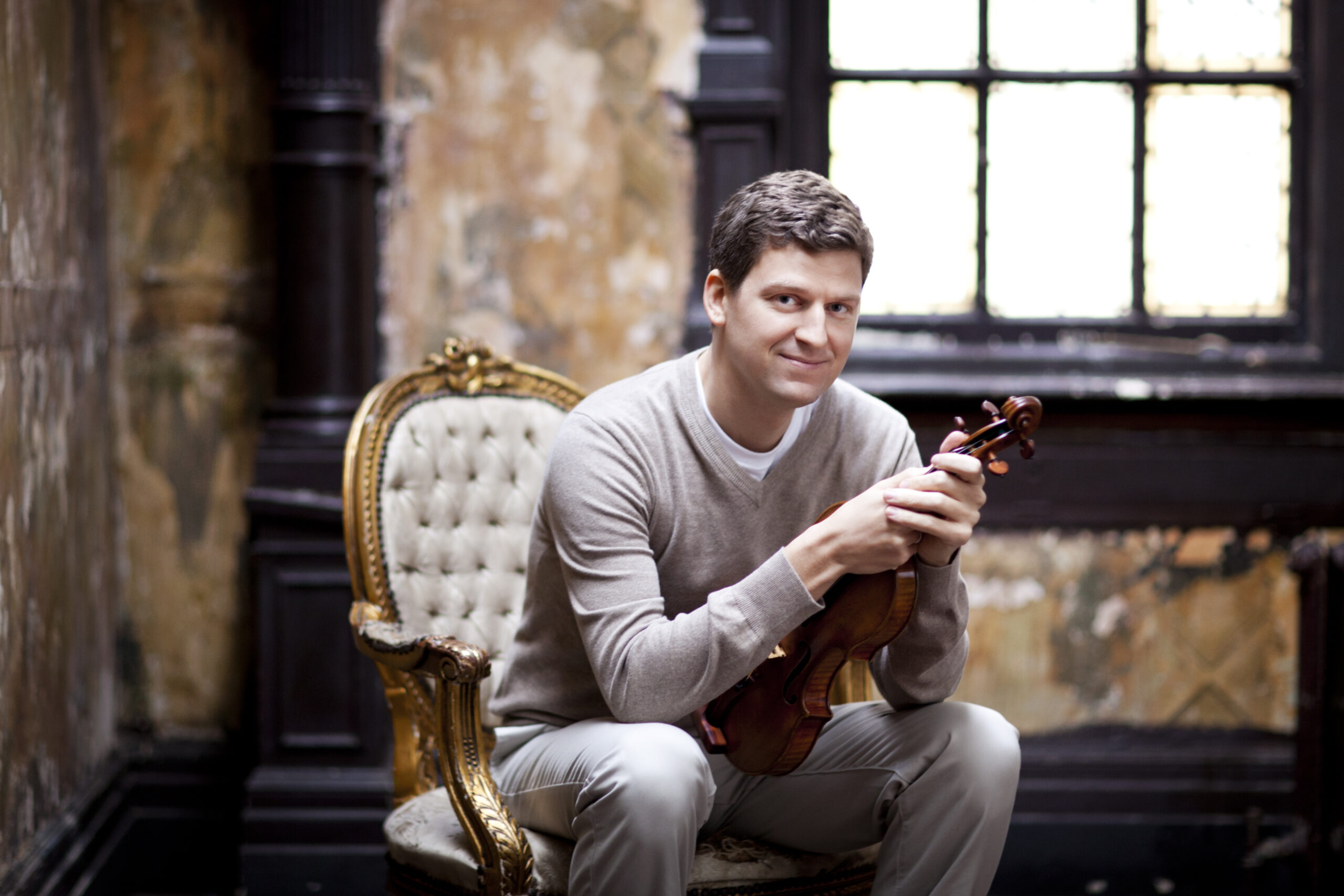It is easy to smile at such reactions, but listening to the very beginning of Beethoven’s Sonata in D Major, one can understand that reviewer’s concerns: far from offering us “nature” or “song,” the opening of this sonata seems to explode in a shower of rockets going off in every direction. The first movement is marked Allegro con brio, with the emphasis on the con brio: this is spirited music, full of busy energy and explosive chords. A flowing second subject seems to promise relief, but the principal impression here is of energy boiling up off the page and unexpected modulations: Beethoven sets the development in
F Major and changes the key signature to be sure that we don’t miss that. After a busy development full of rapid exchanges between the instruments, the movement returns to D Major and rushes to its conclusion on the same massive chord with which it began.
The second movement, marked Andante con moto and set in A Major, is in variation form, and after the hyperactive first movement it brings a measure of calm. At least at first. The piano introduces the gentle eight-measure theme, which is then repeated by the violin. Four variations follow: the first is for piano accompanied by violin, the second for violin with a complex piano accompaniment, the third moves into A minor and turns tempestuous, and the fourth is built on quiet syncopations. A delicate coda draws the movement to its close. The energetic finale, marked simply Allegro, is a rondo in 6/8 whose central theme is energized by off-the-beat accents. This is buoyant music, full of subordinate episodes and piquant pauses. Beethoven teases the audience nicely just before the end.
Sonata for Violin and Piano No. 5 in F Major, Op. 24 “Spring” (1800–1801)
The nickname “Spring” for this sonata did not originate with Beethoven, but this is one of those rare instances when someone else’s nickname for a piece of music is exactly right—no matter how often one has heard this music, it always sounds fresh.
The “Spring” Sonata opens with a long arc of seamless melody, one of the loveliest Beethoven ever wrote. Beethoven first has the violin play it, then—as if reluctant to give up something so beautiful—he gives the same theme to the piano: the double statement of the opening theme extends over 25 measures. If spring is said to go out like a lamb, there is a darker side to this music that reminds us that it can come in like a lion, and one of the particular pleasures of the opening movement is the contrast between the sunny opening melody and the darker secondary material. After an extended development, the movement ends on a fragment of the opening idea.
The Adagio molto espressivo is of extremely simple structure: first the piano and then the violin play the song-like main idea, which develops not through a rise in tension but by increasingly complex ornamentation. An effective touch here is the steady flow of murmuring sixteenth-notes: that rippling, murmuring sound—present throughout almost the entire movement—complements the music’s serenity.
The Scherzo is brilliant. One of Beethoven’s most original movements, it lasts barely a minute—the ear has only begun to adjust to the dazzling asymmetry of its rhythms when it ends. Beethoven intentionally makes it sound “wrong”—the violin appears to be one beat late—and the real fun of this movement comes at the very end, where “wrong” music resolves so gracefully that listeners suddenly become aware just how “right” it has been all along.
The concluding Rondo returns to the mood of the opening movement, for it too is built on what seems to be a never-ending flow of melody, music that spins on effortlessly. Full of good-spirited energy, this movement offers several varied episodes along the way, but the chief impression is the graceful ease of what is some of the sunniest music Beethoven ever wrote.
Sonata for Violin and Piano No. 9 in A Major, Op. 47 “Kreutzer” (1802–1804)
By the beginning of the nineteenth century, Beethoven was beginning to get restless. The young man who had arrived in Vienna in 1792 was a tremendous pianist, but as a composer still had much to learn, and he spent the next decade slowly mastering the High Classical form of Haydn and Mozart. By 1802 he had composed two symphonies, three piano concertos, a set of six string quartets, and numerous sonatas for piano, for violin, and for cello. These had all been acclaimed in Vienna, but in in that same year Beethoven wrote to his friend Werner Krumpholz: “I’m not satisfied with what I’ve composed up to now. From now on I intend to embark on a new path.” That “new path” would become clear late in 1803 with the composition of the “Eroica.” That symphony revolutionized music—it engaged the most serious issues, and in music of unparalleled drama and scope it resolved them.
But even before the “Eroica,” there were indications of Beethoven’s “new path.” Early in 1803 the composer met the violinist George Polgreen Bridgetower (1778–1860). Bridgetower, then 25, was the son of Joanis Fredericus de Augustus, who was of African descent, and Maria Schmid, who was German-Polish. A decade earlier, he had performed in the orchestra for Haydn’s concerts in London and was now establishing himself as a touring virtuoso across Europe. Bridgetower and Beethoven quickly became friends, and when the violinist proposed a joint concert at which they would perform a new sonata, the composer agreed. But, as was often the case, Beethoven found himself pressed for time. He made the process easier by retrieving a final movement that he had written for a violin sonata the previous year and then discarded. Now, in effect working backwards, he rushed to get the first two movements done in time for the scheduled concert on May 22. He didn’t make it. The concert had to be postponed two days, and even then Beethoven barely got it done: he called his copyist at 4:30 that morning to begin copying a part for him, and at the concert he and Bridgetower had to perform some of the music from Beethoven’s manuscript; the piano part for the first movement was still in such fragmentary form that Beethoven was probably playing some of it just from sketches.
As soon as he completed this sonata, Beethoven set to work on the “Eroica,” which would occupy him for the next six months. While the sonata does not engage the heroic issues of the first movement of that symphony, it has something of the Eroica’s slashing power and vast scope. Beethoven was well aware of this and warned performers that the sonata was “written in a very concertante style, quasi-concerto-like.” From the first instant, one senses that this is music conceived on a grand scale. The sonata opens with a slow introduction (the only one in Beethoven’s ten violin sonatas), a cadenza-like entrance for the violin alone.
The piano makes a similarly dramatic entrance, and gradually the two instruments outline the interval of a rising second (E to F#). At the Presto, that interval collapses into a half- step, the movement jumps into A minor, and the music whips ahead. Beethoven provides a chorale-like second subject marked dolce, but this island of calm makes only the briefest of returns in the course of this furious movement. The burning energy of that Presto opening is never far off: the music rips along an almost machine-gun-like patter of eight-notes, and after a hyperactive development, the movement drives to its abrupt cadence.
Relief comes in the Andante con Variazioni. The piano introduces the melody, amiable but already fairly complex, the violin repeats it, and the two instruments briefly extend it. There follow four lengthy and highly elaborated variations, and while the gentle mood of the fundamental theme is never violated, these variations demand some complex and demanding playing. For all its complexities, this is a lovely movement, and Beethoven and Bridgetower had to repeat it at the premiere.
The final movement opens with a bang—a stark A Major chord—and off the music goes. Beethoven had composed this movement, a tarantella, a year earlier, intending that it should be the finale of his Violin Sonata in A Major, Opus 30, No. 1. But he pulled it out and wrote a new finale for the earlier sonata, and that was a wise decision: this fiery finale would have overpowered that gentle sonata. Here, it dances with a furious energy that makes it a worthy counterpart to the first movement. At several points, Beethoven moves out of the driving 6/8 tarantella meter and offers brief interludes in 2/4. These stately, reserved moments bring the only relief in a movement that overflows with seething energy, a movement that here becomes the perfect conclusion to one of the most powerful pieces of chamber music ever written.
Beethoven was so taken with Bridgetower’s playing that he intended to dedicate the sonata to him. And so we might know this music today as the “Bridgetower” Sonata but for the fact that the composer and the violinist quarreled, apparently over a remark that Bridgetower made about a woman Beethoven knew. The two eventually made up, but in the meantime Beethoven had dedicated the sonata to the French violinist Rodolphe Kreutzer, and so we know it today as the “Kreutzer” Sonata. Ironically, Kreutzer did not like this music—Berlioz reported that “the celebrated violinist could never bring himself to play this outrageously incomprehensible composition.”






